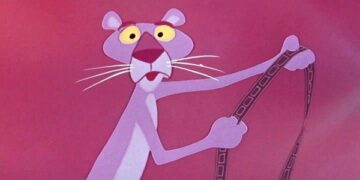

Remember Saturday mornings?
If you’re an American of a certain age, you probably spent a good chunk of them sprawled in front of the TV, absorbing a steady stream of network cartoons peppered with ads for toys and sugared cereal.
One of Saturday morning’s animated stars stood out from the crowd, a lanky, bipedal feline of a distinctly rosy hue.
He shared Bugs Bunny’s anarchic streak, without the hopped-up, motormouthed intensity.
In fact, he barely spoke, and soon went entirely mute, relying instead on Henry Mancini’s famous theme, which followed him everywhere he went.
Above all, he was sophisticated, with a minimalist aesthetic and a long cigarette holder.
Director Blake Edwards attributes his lasting appeal to his “promiscuous, fun-loving, devilish” nature.
John Cork’s short documentary Behind the Feline: The Cartoon Phenomenon, below, details how Edwards charged commercial animators David DePatie and Friz Freleng with creating a cartoon persona for the Pink Panther Diamond in his upcoming jewel heist caper.
DePatie, Freleng and their team drafted over a hundred renderings in response to the character notes Edwards bombarded them with via telegram.
Edward’s favorite, designed by director Hawley Pratt, featured the iconic cigarette holder and appeared in the feature film’s trailer and title sequence, ultimately upstaging a star studded cast including David Niven, Claudia Cardinale, Robert Wagner, and Peter Sellers as Inspector Clouseau.
The cartoon panther’s sensational debut prompted United Artists to order up another 156 shorts, to be released over a four to five year period. The first of these, The Pink Phink, not only established the tone, it also nabbed the Academy Award for 1964’s best animated short.
Although he was created with an adult audience in mind — the narrator of the original theatrical trailer asks him about bedroom scenes — his wordless torment of the simplified cartoon Inspector proved to be money in the bank on Saturday mornings.
The Pink Panther Show ran from 1969 to 1980, weathering various title tweaks and a jump from NBC to ABC.
Syndication and cable TV ensured a vibrant afterlife, here and in other countries, where the character’s sophistication and reliance on body language continues to be a plus.
The plots unfolded along predictable lines — the groovy panther spends 6 minutes thwarting and bedeviling a less cool, less pink-oriented character, usually the Inspector.
Every episode’s title includes a reference to the star’s signature color, often to groaning degree – Pink of the Litter, Pink-A-Boo, The Hand Is Pinker Than the Eye, Pinkcome Tax, The Scarlet Pinkernel….
We won’t ask you to guess the color of Pink Panther Flakes, manufactured under the auspices of Post, a Pink Panther Show co-sponsor.
“I thought it was just fine for the film,” Edwards says of the animated Pink Panther in Cork’s 2003 documentary, “But I had no idea that it would take off like that, that it would have that kind of a life of its own… that kind of a merchandising life of its own. Thank god it did!”
Stay cool this summer with an 11-hour Pink Panther marathon, comprised of the following free compilations of Seasons 1, 2 and 3.
Season 1
Season 2
Season 3
Related Content:
How Looney Tunes & Other Classic Cartoons Helped Americans Become Musically Literate
Peter Sellers Performs The Beatles “A Hard Day’s Night” in Shakespearean Voice
Ayun Halliday is an author, illustrator, theater maker and Chief Primatologist of the East Village Inky zine. Follow her @AyunHalliday.
Watch 11 Hours of The Pink Panther for Free is a post from: Open Culture. Follow us on Facebook and Twitter, or get our Daily Email. And don't miss our big collections of Free Online Courses, Free Online Movies, Free eBooks, Free Audio Books, Free Foreign Language Lessons, and MOOCs.
from Open Culture https://ift.tt/3BlUHSg
via Ilumina







Comments
Post a Comment